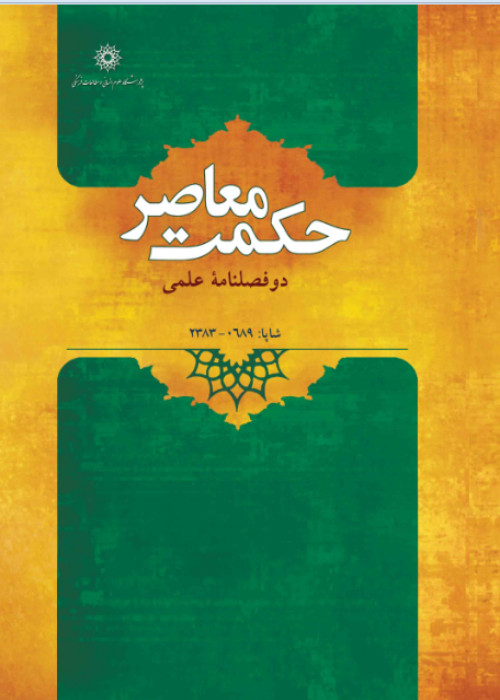Avicenna on the Pleasure of Works of Art and Its Relation to Perceptual Faculties
Avicenna has discussed the pleasure of artistic and natural beauties in several of his works. Avicenna's views on the pleasure of artistic and natural beauties are often expressed under the more general concept of pleasure and are scattered in works with various subjects such as theological, logical, natural and mathematical works. He also discusses pleasure in relation to the perception and the perceptual faculties of the soul. In addition, an important and significant part of Avicenna's discussions about pleasure is devoted to pleasure of the arts, especially the representative arts.Since the work of art is considered sensible, the question arises as to which perceptual faculties of man the pleasure of the work of art depends? Does the mere fact that a work of art is a sensible thing, means that the pleasure of a work of art is considered a sensible pleasure? Do other perceptual faculties, including the internal sensory faculties and the rational faculties, also contribute to the perception of the work of art, and does the pleasure of the work of art also depend on them? In the case of each of these faculties, including the external and internal sensory faculties and the rational faculty, the question can be asked how important and effective they are in perceiving the beauty of the work of art? In the present article, an attempt has been made to answer these questions from Avicenna's point of view. Methods and Materials:The research method of this article is fundamental. This research was conducted using a library research method, and the method of describing and analyzing information in this research is qualitative. The claim of this research is that according to Avicenna's views, the pleasure that is obtained from works of art, as a kind of sensible things, is not merely sensory pleasure and dependent on the five external sensory faculties.
To examine this claim, the characteristics of aesthetic pleasure and its subjects as well as the epistemological status of this pleasure are studied and the pleasure of the arts of poetry, painting and music is explained from Avicenna's point of view. Finally, it is shown that the aesthetic pleasure of works of art is first of all a rational pleasure and depends on the faculty of reason and then, respectively, is an imaginary pleasure and depends on the faculty of imagination, and finally, is a sensible pleasure and depends on the perceptual faculties. Among the faculties of external perception, the faculties of sight and hearing have the greatest ability to obtain aesthetic pleasure from the arts, respectively.
The findings of this study show that from Avicenna's point of view, each of the external and internal sensory faculties, and to a higher degree, the rational faculty, have their own aesthetic pleasure. External sensory faculties, namely sight, hearing, smell, taste, and touch, each have limitations. In this way they can only enjoy what they can comprehend. But the range of pleasure of the internal faculties is much greater than the pleasures of the external faculties. Because all the sensory forms perceived by the external perceptual faculties are grouped together and interconnected, there is more pleasure for the internal faculties. This is why the imaginative faculty enjoys the perception of images preserved in the imagination. For example, the imagination, by preserving and storing sensible auditory forms of musical notes, makes it possible that the audience's pleasure is not limited to single notes and sound type, but can understand the sequence of musical notes and enjoy them. Ultimately, it is the faculty of reason that in the strict sense of the word can enjoy the pleasure of perceiving beauty. Because from Avicenna's point of view, beauty lies in features such as proportion, composition and symmetry, and although the audience first perceives data from a sensible object through sensory perception, but the perception of features such as proportion is specific to reason. Accordingly, aesthetic pleasure is at its highest dependent on rational perception.According to Avicenna, irrational pleasure is a pleasure that is aroused, but without thought and reflection, and is appropriate to nature and the senses, but hearing and sight give pleasures to the soul that are not merely by nature, but are rational, because they refer to nonsensible meanings, for example, when one sees a beautiful work of art, one is drawn to it and tends to liken it.The results of this study show that according to Avicenna, since the external and internal senses present the works of art to the human intellect and the intellect recognizes their beauty, the perception of beauty encompasses all levels of human cognitive faculties. Also, since aesthetic pleasure follows the perception of beauty, the perception of beauty produces different levels of pleasure, at least as much as it involves perceptual levels.
- حق عضویت دریافتی صرف حمایت از نشریات عضو و نگهداری، تکمیل و توسعه مگیران میشود.
- پرداخت حق اشتراک و دانلود مقالات اجازه بازنشر آن در سایر رسانههای چاپی و دیجیتال را به کاربر نمیدهد.




